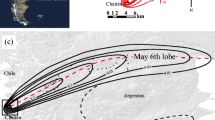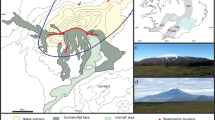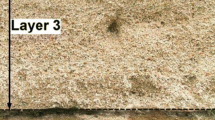Abstract
Sedimentation processes and fragmentation mechanisms during explosive volcanic eruptions can be constrained based on detailed analysis of grain-size variations of tephra deposits with distance from vent and total grain-size distribution (TGSD). Grain-size studies strongly rely on deposit exposure and, in case of long-lasting eruptions, can be complicated by the intricate interplay between eruptive style, atmospheric conditions, particle accumulation, and deposit erosion. The 2011 Cordón Caulle eruption, Chile, represents an ideals laboratory for the study of long-lasting eruptions thanks to the good deposit accessibility in medial to distal area. All layers analyzed are mostly characterized by bimodal grain-size distributions, with both the modes and the fraction of the coarse subpopulation decreasing rapidly with distance from vent and those of the fine subpopulation being mostly stable. Due to gradually changing wind direction, the two subpopulations characterizing the deposit of the first 2 days of the eruption are asymmetrically distributed with respect to the dispersal axis. The TGSD of the climactic phase is also bimodal, with the coarse subpopulation representing 90 wt% of the whole distribution. Polymodality of individual samples is related to size-selective sedimentation processes, while polymodality of the TGSD is mostly related to the complex internal texture (e.g., size and shape of vesicles) of the most abundant juvenile clasts. The most representative TGSD could be derived based on a combination of the Voronoi tessellation with a detailed analysis of the thinning trend of individual size categories. Finally, preferential breakage of coarse pumices on ground impact was inferred from the study of particle terminal velocity.










Similar content being viewed by others
References
Alfano F, Bonadonna C, Connor CB, Volentik A (submitted) From tephra grain-size and dispersal to magma fragmentation: the case of the 2008 Chaitén rhyolitic eruption, Chile. Bull Volcanol
Alfano F, Bonadonna C, Gurioli L (2012) Insights into eruption dynamics from textural analysis: the case of the May, 2008, Chaiten eruption. Bull Volcanol 74(9):2095–2108
Biass S, Bonadonna C (2014) TOTGS: Total grainsize distribution of tephra fallout https://vhub.org/resources/3297 Accessed 26 Jan 2015
Bonadonna C, Costa A (2012) Estimating the volume of tephra deposits: a new simple strategy. Geology 40(5):415–418
Bonadonna C, Houghton BF (2005) Total grainsize distribution and volume of tephra-fall deposits. Bull Volcanol 67:441–456
Bonadonna C, Mayberry GC, Calder ES et al (2002) Tephra fallout in the eruption of Soufrière Hills Volcano, Montserrat. In: Druitt TH, Kokelaar BP (eds) The eruption of Soufrière Hills Volcano, Montserrat, from 1995 to 1999. Geological Society, London, Memoir, pp 483–516
Bonadonna C, Phillips JC, Houghton BF (2005) Modeling tephra sedimentation from a Ruapehu weak plume eruption. Journal of Geophysical Research 110(B8, B08209)
Bonadonna C, Genco R, Gouhier M, et al (2011) Tephra sedimentation during the 2010 Eyjafjallajokull eruption (Iceland) from deposit, radar, and satellite observations. J Geophys Res Solid Earth 116
Bonadonna C, Cioni R, Pistolesi M, et al (2013) Determination of the largest clast sizes of tephra deposits for the characterization of explosive eruptions: a study of the IAVCEI commission on tephra hazard modelling. Bull Volcanol 75(1)
Bonadonna C, Pistolesi M, Cioni R, et al. (2015, in press) Dynamics of wind-affected volcanic plumes: the example of the 2011 Cordón Caulle eruption, Chile. J Geophys Res
Brazier S, Sparks RSJ, Carey SN et al (1983) Bimodal grain-size distribution and secondary thickening in air-fall ash layers. Nature 301(5896):115–119
Brown RJ, Bonadonna C, Durant AJ (2012) A review of volcanic ash aggregation. Phys Chem Earth 45–46:65–78
Carazzo G, Jellinek AM (2012) A new view of the dynamics, stability and longevity of volcanic clouds. Earth Planet Sci Lett 325:39–51
Carazzo G, Jellinek AM (2013) Particle sedimentation and diffusive convection in volcanic ash-clouds. J Geophys Res Solid Earth Planets 118(4):1420–1437
Carey SN, Sigurdsson H (1982) Influence of particle aggregation on deposition of distal tephra from the May 18, 1980, eruption of Mount St-Helens volcano. J Geophys Res 87(B8):7061–7072
Castro JM, Schipper CI, Mueller SP, et al. (2013) Storage and eruption of near-liquidus rhyolite magma at Cordon Caulle, Chile. Bull Volcanol 75(4)
Collini E, Osores SM, Folch A et al (2013) Volcanic ash forecast during the June 2011 Cordon Caulle eruption. Nat Hazards 66(2):389–412
Connor CB, Connor LJ, Bonadonna C, Luhr JF, Savov IP, Navarro-Ochoa C (2015, in press) Modeling tephra thickness and particle size distribution of the 1913 eruption of Volcan de Colima, Mexico. In: Varley N, Komorowski JC (eds) Volcan de Colima—managing the threat. Springer Verlag for the IAVCEI in the Active Volcanoes of the World Series
Dingwell DB, Lavallee Y, Kueppers U (2012) Volcanic ash: a primary agent in the Earth system. Phys Chem Earth 45–46:2–4
Dufek J, Manga M, Patel A (2012) Granular disruption during explosive volcanic eruptions. Nat Geosci 5(8):561–564
Durant AJ, Rose WI (2009) Sedimentological constraints on hydrometeor-enhanced particle deposition: 1992 eruptions of Crater Peak, Alaska. J Volcanol Geotherm Res 186(1–2):40–59
Durant AJ, Rose WI, Sarna-Wojcicki AM, et al. (2009) Hydrometeor-enhanced tephra sedimentation: constraints from the 18 May 1980 eruption of Mount St. Helens. J Geophys Res Solid Earth 114
Durant AJ, Villarosa G, Rose WI et al (2012) Long-range volcanic ash transport and fallout during the 2008 eruption of Chaiten volcano, Chile. Phys Chem Earth 45–46:50–64
Eychenne J, Le Pennec J-L, Troncoso L et al (2012) Causes and consequences of bimodal grain-size distribution of tephra fall deposited during the August 2006 Tungurahua eruption (Ecuador). Bull Volcanol 74(1):187–205
Fisher RV, Schmincke HU (1984) Pyroclastic rocks. pp xiv + 472 pp-xiv + 472 pp
Folch A (2012) A review of tephra transport and dispersal models: evolution, current status, and future perspectives. J Volcanol Geotherm Res 235:96–115
Folch A, Mingari L, Osores MS, Collini E (2014) Modeling volcanic ash resuspension—application to the 14-18 October 2011 outbreak episode in central Patagonia, Argentina. Nat Hazards Earth Syst Sci 14(1):119–133
Fontijn K, Ernst GGJ, Bonadonna C et al (2011) The 4-ka Rungwe Pumice (South-Western Tanzania): a wind-still Plinian eruption. Bull Volcanol 73(9):1353–1368
Gaitán JJ, Ayesa JA, Umaña F, Raffo F, Bran DB (2011) Cartografía del área afectada por cenizas volcánicas en las provincias de Río Negro y Neuquén. In: INTA http://inta.gob.ar/documentos/cartografia-del-area-afectada-por-cenizas-volcanicas-en-las-provincias-de-rio-negro-y-neuquen/
Ganser GH (1993) A rational approach to drag prediction of spherical and nonspherical particles. Powder Technol 77(2):143–152
Hadley D, Hufford GL, Simpson JJ (2004) Resuspension of relic volcanic ash and dust from Katmai: still an aviation hazard. Weather Forecast 19(5):829–840
Hildreth W, Drake RE (1992) Volcano Quizapu, Chilean Andes. Bull Volcanol 54:93–125
Hincks TK, Aspinall WP, Baxter PJ et al (2006) Long term exposure to respirable volcanic ash on Montserrat: a time series simulation. Bull Volcanol 68(3):266–284
Hobbs PV, Hegg DA, Radke LF (1983) Resuspension of volcanic ash from Mount St-Helens. J Geophys Res Oceans Atmos 88(NC6):3919–3921
Inman DL (1952) Measures for describing the size distribution of sediments. J Sediment Petrol 22:125–145
INTA (2011), Estado de situación derivado de las cenizas del complejo volcánico Puyehue –Cordón caulle en la provincia del Chubut Rep., INTA http://inta.gob.ar/documentos/cartografia-del-area-afectada-por-cenizas-volcanicas-en-las-provincias-de-rio-negro-y-neuquen Accessed 26 Jan 2015
Kaminski E, Jaupart C (1998) The size distribution of pyroclasts and the fragmentation sequence in explosive volcanic eruptions. J Geophys Res Solid Earth 103(B12):29759–29779
Kueppers U, Scheu B, Spieler O, Dingwell DB (2006) Fragmentation efficiency of explosive volcanic eruptions: a study of experimentally generated pyroclasts. J Volcanol Geotherm Res 153(1–2):125–135
Leadbetter SJ, Hort MC, von Lowis S, et al. (2012) Modeling the resuspension of ash deposited during the eruption of Eyjafjallajokull in spring 2010. J Geophys Res Atmos 117
Legros F (2000) Minimum volume of a tephra fallout deposit estimated from a single isopach. J Volcanol Geotherm Res 96:25–32
Manzella I, Bonadonna C, Phillips JC, Monnard H (2015) The role of convective instabilities in deposition of volcanic ash. Geology. doi:10.1130/G36252.1
Mastin LG, Bonadonna C, Folch A, Webley P, stunder B, Pavolonis M (2013) "Eruption data for ash-cloud model validation," https://vhub.org/resources/2431 Accessed 26 Jan 2015
Murrow PJ, Rose WI, Self S (1980) Determination of the total grain-size distribution in a vulcanian eruption column, and its implications to stratospheric aerosol perturbation. Geophys Res Lett 7(11):893–896
Perugini D, Speziali A, Caricchi L, Kueppers U (2011) Application of fractal fragmentation theory to natural pyroclastic deposits: Insights into volcanic explosivity of the Valentano scoria cone (Italy). J Volcanol Geotherm Res 202(3–4):200–210
Pistolesi M, Cioni R, Bonadonna C, et al (2015) Complex dynamics of small-moderate volcanic events: the example of the 2011 rhyolitic Cordón Caulle eruption, Chile. Bull Volcanol. doi:10.1007/s00445-014-0898-3
Prata AJ, Grant IF (2001) Retrieval of microphysical and morphological properties of volcanic ash plumes from satellite data: application to Mt Ruapehu, New Zealand. Q J R Meteorol Soc 127(576):2153–2179
Pyle DM (1989) The thickness, volume and grainsize of tephra fall deposits. Bull Volcanol 51(1):1–15
Rose WI, Self S, Murrow PJ, et al. (2007) Nature and significance of small volume fall deposits at composite volcanoes: insights from the October 14, 1974 Fuego eruption, Guatemala. Bull Volcanol
Rust AC, Cashman KV (2011) Permeability controls on expansion and size distributions of pyroclasts. J Geophys Res Solid Earth 116
Scasso R, Corbella H, Tiberi P (1994) Sedimentological analysis of the tephra from 12-15 August 1991 eruption of Hudson Volcano. Bull Volcanol 56:121–132
Schipper CI, Castro JM, Tuffen H, James MR, How P (2013) Shallow vent architecture during hybrid explosive-effusive activity at Cordón Caulle (Chile, 2011-12): evidence from direct observations and pyroclast textures. J Volcanol Geoth Res 262:25–37. doi:10.1016/j.jvolgeores.2013.06.005
Scollo S, Del Carlo P, Coltelli M (2007) Tephra fallout of 2001 Etna flank eruption: analysis of the deposit and plume dispersion. J Volcanol Geotherm Res 160(1–2):147–164
SERNAGEOMIN/OVDAS (2011) Puyehue - Cordón Caulle: Reporte especial de actividad volcánica No31. In: http://www.sernageomin.cl/volcan.php?pagina=7&iId=38
Sparks RSJ, Wilson L, Sigurdsson H (1981) The pyroclastic deposits of the 1875 eruption of Askja, Iceland. Philos Trans R Soc Lond 229:241–273
Thorsteinsson T, Johannsson T, Stohl A, Kristiansen NI (2012) High levels of particulate matter in Iceland due to direct ash emissions by the Eyjafjallajokull eruption and resuspension of deposited ash. J Geophys Res Solid Earth 117
Varekamp JC, Luhr JF, Prestegaard KL (1984) The 1982 eruptions of El-Chichon Volcano (Chiapas, Mexico)—character of the eruptions, ash-fall deposits, and gas-phase. J Volcanol Geotherm Res 23(1–2):39–68
Volentik ACM, Bonadonna C, Connor CB et al (2010) Modeling tephra dispersal in absence of wind: insights from the climactic phase of the 2450 BP Plinian eruption of Pululagua volcano (Ecuador). J Volcanol Geotherm Res 193(1–2):117–136
Waitt RB, Jr., Hansen VL, Sarna-Wojcicki AM, Wood SH (1981) Proximal air-fall deposits of eruptions between May 24 and August 7, 1980-stratigraphy and field sedimentology Mount St. Helens. In: Lipman PW, Mullineaux DR (eds) The 1980 eruptions of Mount St. Helens, Washington. U.S. Geological Survey Professional Paper Washington, D.C., pp 617-628
Walker GPL (1981) Characteristics of two phreatoplinian ashes, and their water-flushed origin. J Volcanol Geotherm Res 9:395–407
Wiesner MG, Wetzel A, Catane SG et al (2004) Grain size, areal thickness distribution and controls on sedimentation of the 1991 Mount Pinatubo tephra layer in the South China Sea. Bull Volcanol 66(3):226–242
Wilson TM, Cole JW, Stewart C et al (2011) Ash storms: impacts of wind-remobilised volcanic ash on rural communities and agriculture following the 1991 Hudson eruption, southern Patagonia, Chile. Bull Volcanol 73(3):223–239
Wilson TM, Stewart C, Bickerton H, et al. (2013) Impacts of the June 2011 Puyehue-Cordon Caulle volcanic complex eruption on urban infrastucture, agricolture and public health. In: GNS Science Report 2012/20.
Wohletz KH, Sheridan MF, Brown WK (1989) Particle-size distributions and the sequential fragmentation/transport theory applied to volcanic ash. J Geophys Res Solid Earth Planets 94(B11):15703–15721
Acknowledgments
C. Bonadonna was supported by the Swiss National Science Foundation (SNSF; No. 200020_125024). M. Pistolesi and R. Cioni were supported by the Italian Ministero Universita’ e Ricerca funds (PRIN 2008—AshErupt project. The authors are grateful to A. Bertagnini, R. Gonzales, L. Francalanci, and P. Sruoga for their assistance in the field and to L. Dominguez for her help in grain size analyses. Many thanks also to A. Costa, L. Pioli, and L. Connor for constructive discussion. Both V. Manville (associate editor) and U. Kueppers are thanked for thorough review.
Author information
Authors and Affiliations
Corresponding author
Additional information
Editorial responsibility: V. Manville
Appendices
Appendix 1
Isomass maps of individual ϕ categories for unit I (cumulative A to F layers) in kg m-2

Appendix 2
Calculation of particle terminal velocity
Particle terminal velocity was calculated with the equation of Ganser (1993) for the mean diameter within each half-ϕ size bin (assuming a Gaussian size distribution within each size bin) and averaged over sedimentation height (1 to 14 km a.s.l. for A–F, 1 to 12 km a.s.l. for H, and 1 to 10 km a.s.l. for K2; maximum plume heights were considered for all phases). Sphericity was kept at 0.9 for both clast categories (e.g., Folch 2012). Particle density was measured for individual clast sizes by Pistolesi et al. (2015) (see Fig. 9b, e, h). In Fig. 11, we show results for individual layers A to F.
Componentry (left column) and terminal velocity (right column) of tephra clasts ranging from 0 to −4.5ϕ (i.e., 1–22.6 mm) for layers A to F at a locality about 15 km from vent on the dispersal axis for unit I. See also Fig. 9 for results of the other layers
Appendix 3
Calculation of the total grain-size distribution of unit I
In order to account for the missing distal data in the derivation of the total grain size distribution of the A–F cumulative layer (i.e., unit I), we have derived the mass/area of six points about 600 km from vent from the isopach maps compiled soon after the eruption by Gáitan et al. (2011) and the . Based on these two maps that also describe the distal deposit, we assigned to the six distal data a thickness of 0.1 cm (i.e., 0.8 kg m−2 based on our most distal value of deposit density, i.e., 834 kg m−3; Fig. 5) and the grain size shown in Fig. 12. The two maps (based on dataset 1 and 2) are compared in Fig. 13.
Grain size distribution derived for the distal points (610 km from vent; blue histograms) based on the distribution of our most distal sample at 240 km from vent (red histograms) and on the proportion of lapilli, coarse ash, and fine ash as derived from the best-fit equations in Fig. 3a, main text (i.e., Gaussian distribution with mode of 7ϕ and composed of 99 % fine ash)
Maps showing the Voronoi triangulation and the zero line used for the determination of the total grain size distribution based on the Voronoi tessellation method of Bonadonna and Houghton (2005) and using the application of Biass and Bonadonna (2014) for: a dataset 1 (i.e., samples collected in our field surveys) and b dataset 2 (dataset 1 combined with six distal points derived from the isopach maps compiled soon after the eruption by Gaitán et al. (2011) and the INTA (2011))
Plot of Log(erupted mass) vs. plume height (km) (above sea level) showing the minimum values (dark blue) of the goodness-of-fit measure (root mean square error, RMSE) associated with individual ϕ size categories (indicated in each plot) of the climactic phase of Córdon Caulle eruption (i.e., unit I)
Best-fit plume height above sea level as derived from inversion on individual grain size categories (average value = 13.9 km). The mass along the eruptive plume in the model TEPHRA2 is described by a beta function characterized by two parameters, α and β (Connor et al. 2015, in press). For simplicity, in these inversion calculations, α is kept constant (i.e., 3) and β is left vary between 0.5 (i.e., particles are mostly released at the top of the cloud) and 2 (i.e., particles are released at a height which is 60–70 % the total height). Average best-fit value for the climactic phase of Córdon Caulle eruption is 1.8 (i.e., particles are mostly released at a height which is 70 % the total height)
Appendix 4
Inversion on grain size using the model TEPHRA2
Rights and permissions
About this article
Cite this article
Bonadonna, C., Cioni, R., Pistolesi, M. et al. Sedimentation of long-lasting wind-affected volcanic plumes: the example of the 2011 rhyolitic Cordón Caulle eruption, Chile. Bull Volcanol 77, 13 (2015). https://doi.org/10.1007/s00445-015-0900-8
Received:
Accepted:
Published:
DOI: https://doi.org/10.1007/s00445-015-0900-8









